Addressing Climate Change
Promoting Decarbonization in Production
Promoting Energy Savings at Production Sites
Konica Minolta regards the reduction of total energy consumption across the Group as an effective means of achieving net-zero CO2 emissions. At production and R&D sites, which account for a significant share of the Group’s emissions, energy efficiency is being improved and various measures are implemented to cut CO2 emissions.
Optimization of Energy Use
Konica Minolta promotes the optimization of energy use at its production and R&D sites by leveraging its accumulated expertise in energy management and plant operations, particularly in identifying and eliminating inefficiencies. This is further supported by the application of know-how from Material Flow Cost Accounting (MFCA). The company undertakes efforts not only to quantify energy consumption and energy-saving effects, but also to share and deploy successful energy-saving measures horizontally across its sites.
Beyond site-level initiatives, Konica Minolta has established a framework in which employees with specialized knowledge in energy management and operational efficiency assess local conditions across the Group and formulate targeted strategies for reducing energy consumption. These initiatives are systematically implemented and advanced throughout the organization.
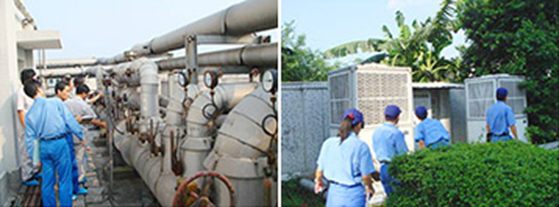
Diagnosing Energy Use through On-Site Assessments
Examples of Main Measures
| Improve productivity | Industrial engineering (IE) work analysis, yield rate improvement, installation of automatic machines, takt time reduction, production space optimization |
|---|---|
| Optimize equipment operation time | Shutdown during downtime, reduction of standby power consumption |
| Reconsider air conditioning operation | Temperature setting optimization, operating time optimization |
| Save energy in lighting | Thinning out lighting, conversion to high-efficiency lighting |
| Save energy in molding machines | Infrared heating, installation of servo motors, cylinder insulation |
| Save energy in compressed air | Installation of inverters, limited number of units, air pressure optimization |
| Optimize refrigerator operation | Refrigerator integration, reconsideration of exit temperature setting |
| Use waste heat | Heat exchange at exhaust/intake, reduction of steam production by using waste heat from dehumidifiers |
| Reduce heat radiation loss | Steam piping insulation, piping integration, reduction of valve leaks |
Examples of Initiatives
TOPIC|Introducing the State-of-the-Art Energy-Saving Equipment
(Konica Minolta Mechatronics, Inc.)
Konica Minolta Mechatronics headquarters (Digital Manufacturing Center MIKAWA) , which began full-scale operations in June 2021, has installed the latest high-efficiency equipment, including a large temperature difference air conditioning system, two separate chillers, direct expansion coil-type total heat exchangers, and LED lighting. Compared with conventional facilities, this installed system reduces CO2 emissions by more than 400 metric tons per year. A photovoltaic power generation system has been installed on the rooftop, and the electricity generated is consumed in-house, contributing to the realization of a decarbonized society.
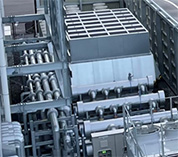
Chiller that improves energy efficiency by dividing the system into two temperature zones for different applications
Pursuing Energy Savings by Reviewing the Operation of Clean Rooms with High Energy Loads
(Konica Minolta Business Technologies (Dongguan) Co., Ltd.)
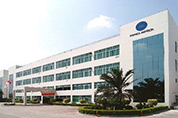
Konica Minolta Business Technologies (Dongguan) Co., Ltd.
Konica Minolta Business Technologies (Dongguan) Co., Ltd., which manufactures MFPs and other products in Dongguan, Guangdong Province, China, has achieved dramatic energy savings by conducting reviews of the operational status of clean rooms with high energy loads in the factory. Specifically, it took another look at the temperature and humidity conditions while keeping them within product specification requirements, shutting off air conditioning on holidays, optimized the ventilation frequency while maintaining cleanliness, reduced clean room equipment operating time by installing a timer, and reduced clean room floor space through layout review. The implementation of these measures has saved energy used by cold energy source equipment and ventilation equipment.
Utilizing Waste Heat from Production and Curbing Heat Dissipation to Ensure Energy Conservation
(Konica Minolta Supplies Manufacturing Co., Ltd.)
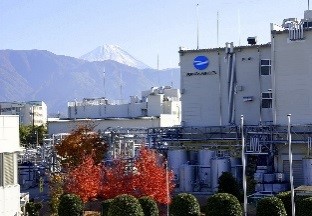
Kofu head office at Konica Minolta Supplies Manufacturing Co., Ltd.
With its head office in Kofu, Yamanashi Prefecture, Konica Minolta Supplies Manufacturing Co., Ltd. makes developers and photosensitive drums for multi-functional peripherals (MFPs). The company has achieved sharp reductions in energy consumption by utilizing the waste heat from the toner production process and curbing the heat dissipation from steam pipes.
Heat exchange with high-temperature water is typically used, but the company actively uses the waste heat from low-temperature water generated in the toner production process through heat exchange and produces heated water to be used in other processes. This significantly reduces the gas consumed to produce heated water.
The company also installed an automated control system to supply steam only when and in amounts needed to prevent heat from dissipating from the pipes.
In addition, outside air is used for drying, but the amount of air required differs significantly depending on fluctuations in the humidity of the outside air. The company controls the dew point of the outside air sucked in constantly, then curbs the blower’s air volume and number of rotations to conserve energy. It has also upgraded from NAS batteries to large-capacity lithium ion rechargeable batteries in order to adapt to momentary power interruptions and power outages. As a result, heaters no longer have to be used, conversion loss has been reduced and efficiency has improved, delivering significant energy conservation.
Pursuing Energy Savings with High-Efficiency Air Conditioning Systems and Other Energy-Saving Measures
(Konica Minolta Business Technologies (Malaysia) Sdn. Bhd.)
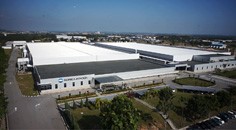
Konica Minolta Business Technologies (Malaysia) Sdn. Bhd.
Konica Minolta Business Technologies (Malaysia) Sdn. Bhd., which assembles MFPs, has achieved major energy savings by actively employing high-efficiency air conditioning systems.
Since Malaysia is a tropical country where air conditioning use is high, the company has installed a large-temperature-difference air conditioning system and a temperature-stratified air-conditioning system and thus has reduced electricity consumption compared with conventional air conditioning.
In the areas between each factory building, dedicated individual air conditioners had been required, but individual air conditioners were discontinued by supplying surplus cold air from air conditioners in other processes.
Furthermore, in the resin molding process, vented cylinders were installed to remove the moisture and gas contained in resin, during the process. As a result, the drying step that was required before resin could be utilized is no longer necessary, resulting in significant energy savings and improved productivity. In this way, the company has promoted high-efficiency air conditioning operations throughout the plant, along with production process improvements.
Thermal insulation for pipes to reduce dissipative heat loss
Konica Minolta Chemical Co., Ltd.
Konica Minolta Chemical, which manufactures chemical products in Japan, worked to reduce dissipative heat loss from pipes created in boilers, and particularly unheated parts such as flanges and valves. Thermography is used to measure surface temperature and identify areas of high heat dissipation. This allowed pipes to be efficiently insulated, reducing heat dissipation loss.

Installing a Gas Turbine Cogeneration System That Provides High Energy Efficiency by Effectively Using Exhaust Heat
On February 1, 2017, the Konica Minolta Kobe Site began operating a gas turbine cogeneration system that uses city gas as fuel. This system provides distributed power generation (7,000 kW class power generation output) that generates power in the places where energy is needed. By effectively utilizing exhaust heat generated at that time, it is possible to achieve overall efficiency at a high 80-90% energy efficiency (general thermal power plants are at about 40%), which greatly contributes to energy saving and CO2 emission reduction.
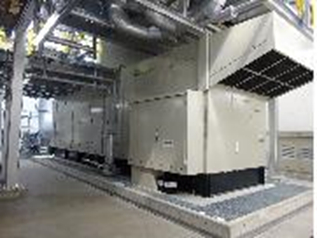
Gas turbine
This system is superior from the standpoints of both energy saving and environmental preservation because the fuel uses city gas with high combustion efficiency and low impurity, generates virtually no dust or sulfur oxides, and generates low amounts of nitrogen oxides thanks to the latest low-NOx combustion technology.
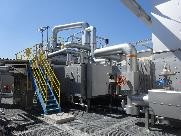
Boiler
Primary Advantage of Installation
CO2 reduction: CO2 reduction of 20% or more compared with previous methods
Peak cut: Leveling of electricity demand: Electric power peak cut rate is 70%
BCP: The system supplies power to the premises critical load in the case of emergency
Subsidies: Subsidy support was received from the Energy Use Rationalization Business Support Program, in recognition of the high energy savings of the installed equipment.
At this site, the company has continued to install energy-saving equipment and streamline product manufacturing processes. The operation of this system is positioned as the core of the energy saving and CO2 emissions reduction plan.
New Environmentally Friendly Research Building SKT
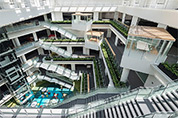
SKT’s atrium
The new R&D building (SKT) opened in April 2014 at Konica Minolta Tokyo Site Hachioji integrates environmental facilities that will contribute to environmental impact reduction, including solar panels on the roof, an atrium that brings in lots of natural light, daylight sensors to reduce lighting electricity consumption, effective natural ventilation, and use of well water. As a building with excellent environmental friendliness, SKT received the highest certification, “Class S,” in the Comprehensive Assessment System for Built Environment Efficiency (CASBEE), which is an evaluation of the environmental performance of buildings led by Japan’s Ministry of Land, Infrastructure, Transport and Tourism. The building also won a fiscal 2014 Good Design Award from the Japan Institute of Design Promotion (JDP).


